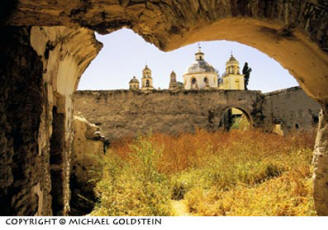
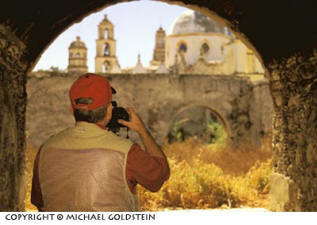
The Sanctuario de Atotonilco, to which our group was taken as a field trip, is a religious center about twenty kilometres outside of San Miguel de Allende. The center consists of a large church, still very much in use, together with some ruins of former living quarters.
The church building itself is rather static as a photograph, but some exploration in the area revealed the opportunity to photograph it framed by several arches in the ruins. A blue – yellow Cokin polarizer made the colors of stone and adobe glow in the midday light, and some flash opened up the details of the framing arch.
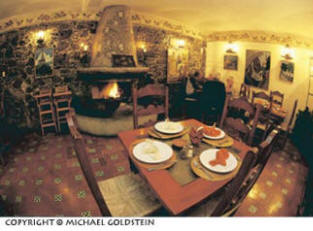
The Casa Payo restaurant on Zacateros Street touts itself as an Argentinian steak house, but its beef comes from México. It’s one of the more attractive eateries in San Miguel de Allende, containing a number of different alcoves and eating areas.
This room, at the rear of the restaurant, was the largest, and most attractive. I used my 15mm fish-eye lens to photograph it, employing a set table as a foreground. The staff were kind enough to light a large fire for me, and a slow shutter speed enabled its light to record on to the film. I bounced flash from the white ceiling to open up shadows.
I often use the corner of an available table, bed, or perhaps a swimming pool, in the immediate foreground, to provide leading lines into a composition. In this case, the ultra-wide lens slightly distorted the table, but not enough to seriously disturb the eye.
I’ve found, in making restaurant shots over the years, that it’s far better to use an attractive empty table as a foreground, rather than try to include diners. Unless professional models are available, most restaurant diners do not appear attractive when photographed in mid meal, nor does their table appear less than chaotic.
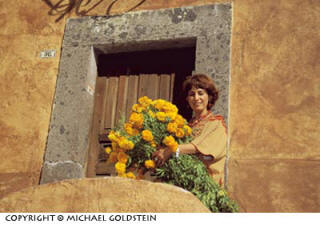
I followed this attractive woman up a steep hill for several blocks, struggling to keep up with her despite my load of tripod and camera bag. Finally, she turned into her house entrance, and I was able to “chat her up” for a few minutes, while trying not to gasp and pant!
My “opening ploy” was to comment on her huge bunch of lovely flowers, followed by the observation that she, and her flowers, complimented the colors of the front of her home beautifully.
Unaware that she was the target for MacDuff Everton’s “techniques for approaching photogenic strangers” (my words, not his!), she agreed to being photographed. I had her move slightly, so that the bright flowers were in front of the relatively dark door, while explaining what I was doing.
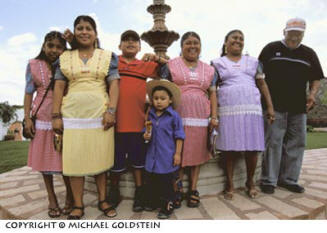
As I was walking through the hotel grounds, I found this family group photographing each other with a small digital camera. I approached them while they were still gathered by the fountain, commenting on how attractive they all looked, and what a wonderful picture they were going to have, and asked if I could photograph them by the fountain.
The first shot was very stilted and “posed”, so I called out to the mother in Spanish: “Ah, Senora, parece que tú eres tan triste!” (Oh, Madam, you appear to be so sad!)My grammar may have been a tad fractured, but they all understood me, and while they were laughing at my comment, I made this image.
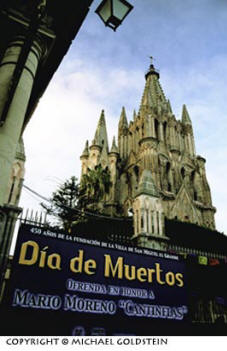
La Parroguia(literally, “the parish church”) is the tallest building in San Miguel, and is without doubt its “destination specific” feature. In any other city, it would be called a “cathedral”, and it is as impressive a structure as any cathedral I have seen. The central plaza in front of it (known as El Jardin, or “the garden”), is surrounded by restaurants, and is the gathering place for the city’s citizens. Anything that is going to happen in San Miguel will happen here.
In early November Mexicans celebrate El Día de Muertos, the “Day of the Dead”, an unusual fiesta during which the dead are honored, with parties in cemeteries, static displays (called ofrendas) on streets and in buildings, and gatherings in town centers.
This image was made with a wide-angle lens on a cloudy morning, using flash to brighten up the foreground poster. The church rearing against the sky is a dramatic composition, the “worm’s eye view”. An effort was made to frame the church with the foreground fence and the surrounding building, to avoid excessive “negative space” around the structure.
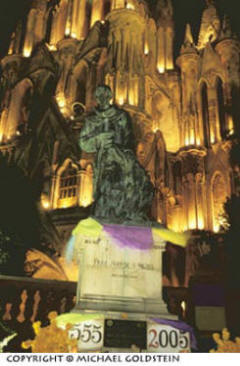
On many evenings, La Parroquia, the “destination – specific” parish church in the center of the historic district of San Miguel de Allende, is lit up like a Christmas tree, and makes for wonderful time-exposure images.
The statue, which I illuminated with flash, is that of Brother Juan de San Miguel, a priest that figured prominently in the early history of this area. The “worm’s eye view”, using a wide-angle lens, provided a dramatic view of the statue with the church in the background.
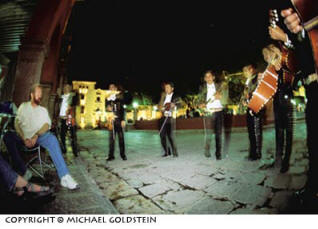
On one weekend evening, I found a mariachi band playing in El Jardin, the central plaza of San Miguel de Allende, entertaining patrons of the surrounding restaurants. After several early efforts using a variety of lenses, I managed to include myself within the semi-circle of the band members, sitting on the ground right at the feet of the guitar player.
This was another occasion where I was able to use my newfound technique, that of firing the flash after a long, hand-held time – exposure, under low – light conditions. Using a 15mm fisheye lens, I was able to include all of the band in my composition. However, by excluding much of the guitar player, and shifting my view slightly, I could also include part of the audience!
Although I had my tripod with me, this was an occasion where it was impossible to use it, and I was pleased to see how steadily I could hold the camera during a four-second shutter speed.
In exposures such as this, a decision must be made as to whether to use rear-curtain flash sync (firing the flash at the end of the exposure), or to capture action first by using front-curtain flash sync. In this case, I used rear-curtain sync, so that the band players would appear to be in front of the surrounding buildings. This worked only because the players were more or less stationary.
by Michael and Allison Goldstein

Leave a Reply